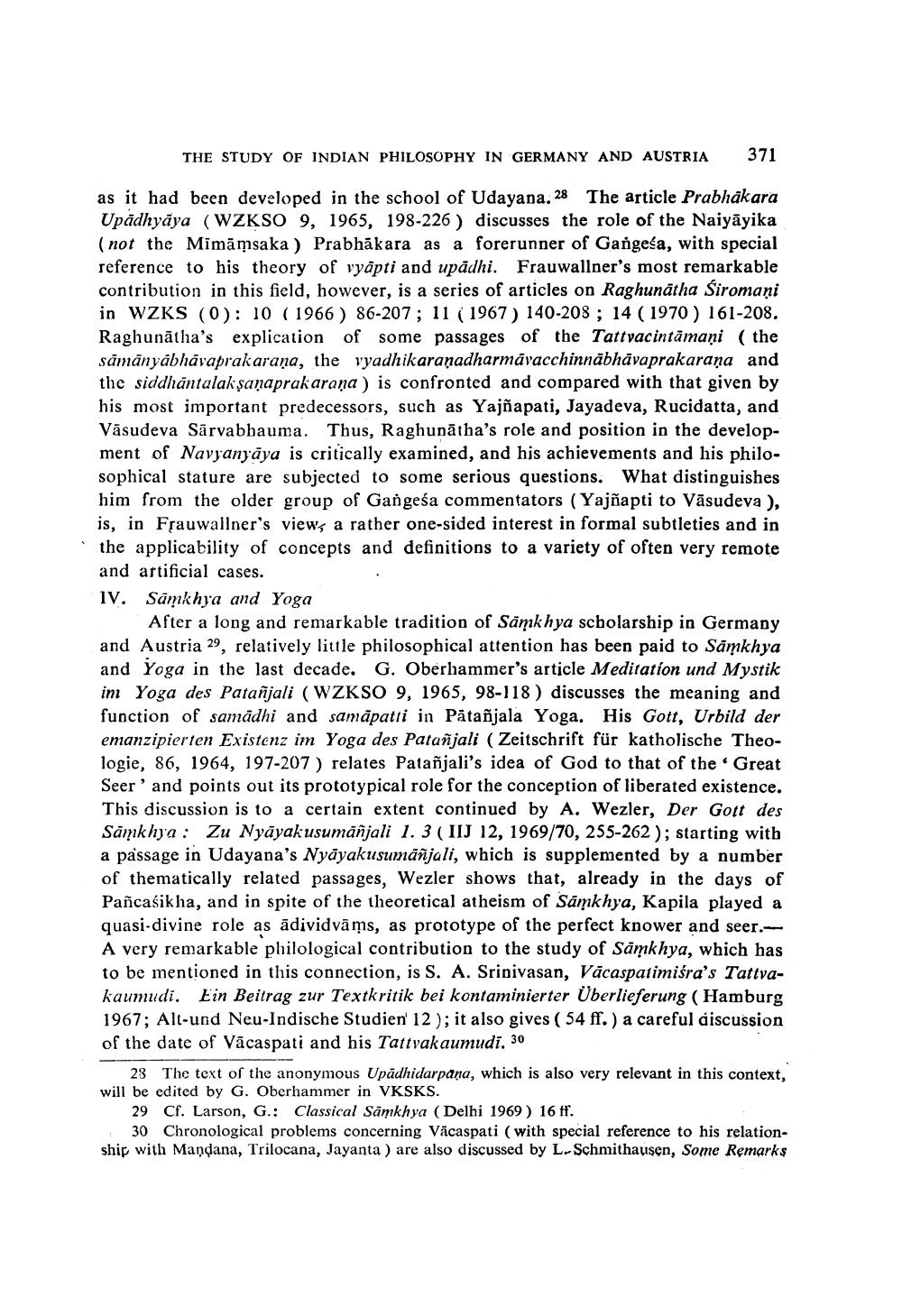________________
THE STUDY OF INDIAN PHILOSOPHY IN GERMANY AND AUSTRIA
371
as it had been developed in the school of Udayana. 28 The article Prabhakara Upadhyaya (WZKSO 9, 1965, 198-226) discusses the role of the Naiyayika (not the Mimāmsaka) Prabhakara as a forerunner of Gangesa, with special reference to his theory of vyapti and upadhi. Frauwallner's most remarkable contribution in this field, however, is a series of articles on Raghunatha Širomani in WZKS (0): 10 (1966) 86-207; 11 (1967) 140-208; 14 (1970) 161-208. Raghunatha's explication of some passages of the Tattvacintamani (the sāmānyābhāvaprakaraṇa, the vyadhikaraṇadharmāvacchinnābhāvaprakarana and the siddhantalakṣaṇaprakaraṇa) is confronted and compared with that given by his most important predecessors, such as Yajñapati, Jayadeva, Rucidatta, and Vasudeva Sarvabhauma. Thus, Raghunatha's role and position in the development of Navyanyaya is critically examined, and his achievements and his philosophical stature are subjected to some serious questions. What distinguishes him from the older group of Gangeśa commentators (Yajñapti to Vasudeva ), is, in Frauwallner's view, a rather one-sided interest in formal subtleties and in the applicability of concepts and definitions to a variety of often very remote and artificial cases.
IV. Samkhya and Yoga
After a long and remarkable tradition of Samkhya scholarship in Germany and Austria 29, relatively little philosophical attention has been paid to Samkhya and Yoga in the last decade. G. Oberhammer's article Meditation und Mystik im Yoga des Patanjali (WZKSO 9, 1965, 98-118) discusses the meaning and function of samādhi and samāpatti in Pātañjala Yoga. His Gott, Urbild der emanzipierten Existenz im Yoga des Patanjali (Zeitschrift für katholische Theologie, 86, 1964, 197-207) relates Patanjali's idea of God to that of the Great Seer' and points out its prototypical role for the conception of liberated existence. This discussion is to a certain extent continued by A. Wezler, Der Gott des Samkhya: Zu Nyayakusumāñjali 1. 3 (IIJ 12, 1969/70, 255-262); starting with a passage in Udayana's Nyāyakusumāñjali, which is supplemented by a number of thematically related passages, Wezler shows that, already in the days of Pañcasikha, and in spite of the theoretical atheism of Samkhya, Kapila played a quasi-divine role as adividvāms, as prototype of the perfect knower and seer.A very remarkable philological contribution to the study of Samkhya, which has to be mentioned in this connection, is S. A. Srinivasan, Vācaspatimiśra's Tattvakaumudi. Ein Beitrag zur Textkritik bei kontaminierter Überlieferung (Hamburg 1967; Alt-und Neu-Indische Studien 12); it also gives (54 ff.) a careful discussion of the date of Vacaspati and his Tattvakaumudī. 30
28 The text of the anonymous Upadhidarpana, which is also very relevant in this context, will be edited by G. Oberhammer in VKSKS.
29 Cf. Larson, G.: Classical Samkhya (Delhi 1969) 16 ff.
30 Chronological problems concerning Vacaspati (with special reference to his relationship with Mandana, Trilocana, Jayanta ) are also discussed by L. Schmithausen, Some Remarks




